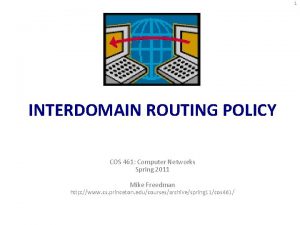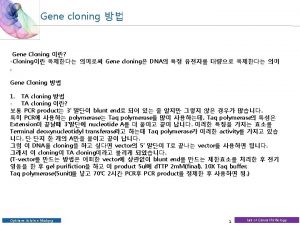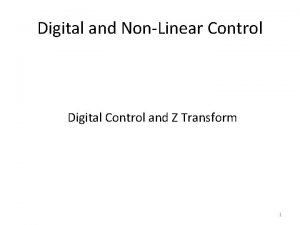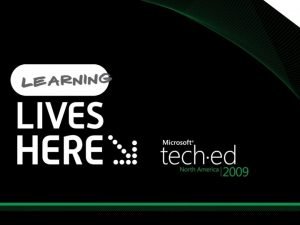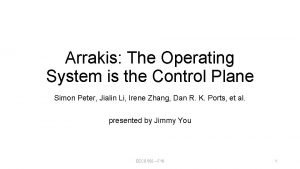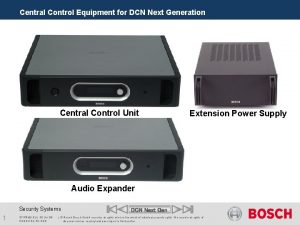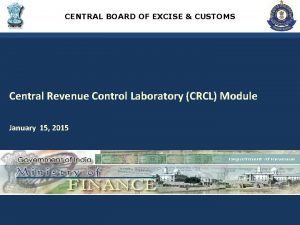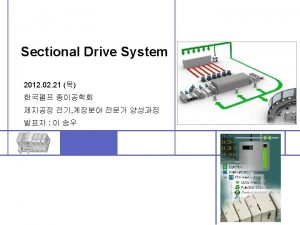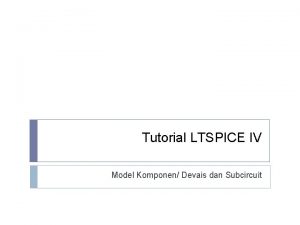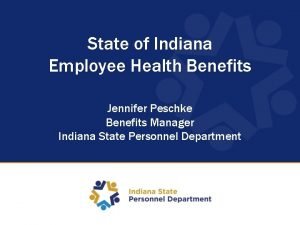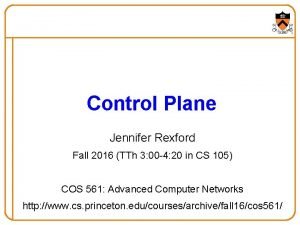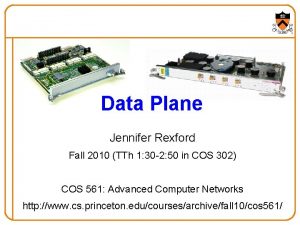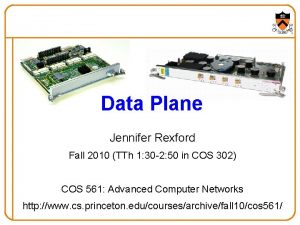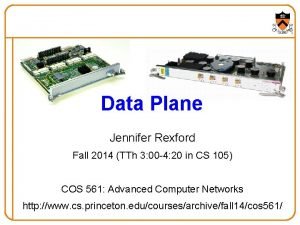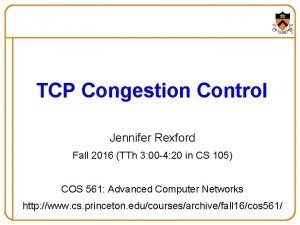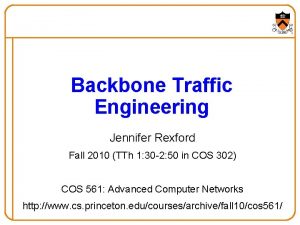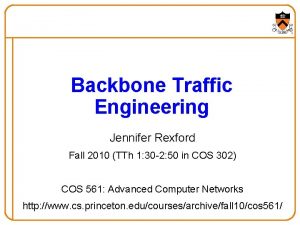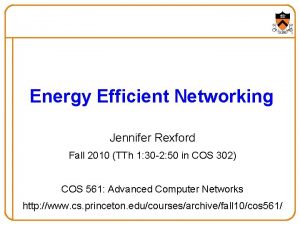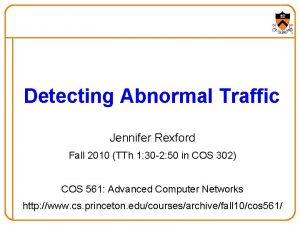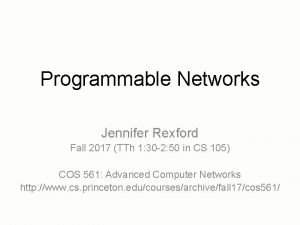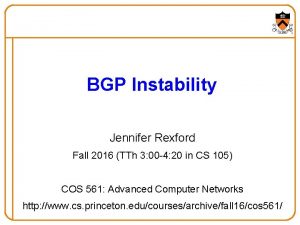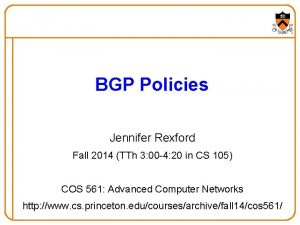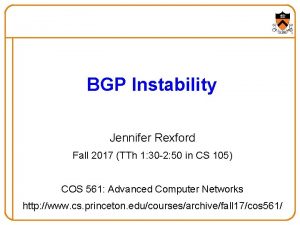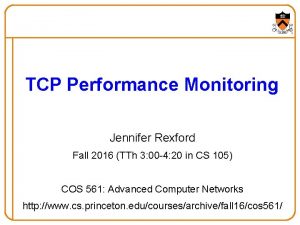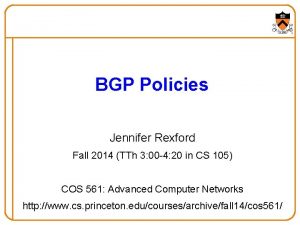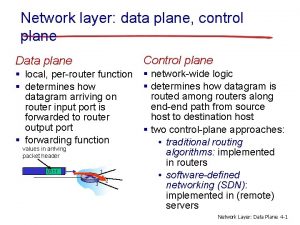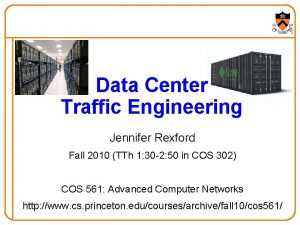Central Control Plane Jennifer Rexford Fall 2010 TTh







































- Slides: 39

Central Control Plane Jennifer Rexford Fall 2010 (TTh 1: 30 -2: 50 in COS 302) COS 561: Advanced Computer Networks http: //www. cs. princeton. edu/courses/archive/fall 10/cos 561/

Outline • Motivation for refactoring the “planes” • Central control plane – Routing Control Platform (RCP) – 4 D architecture – Open. Flow/NOX • Technical challenges – Scalability, reliability, failover time, security, consistency, backwards compatibility • Discussion of the papers 2

Today’s IP Routers configuration • Management plane monitoring – Construct network-wide view – Configure the routers OSPF BGP FIB • Control plane OSPF BGP – Track topology changes – Compute routes and install forwarding tables • Data plane FIB – Forward, filter, buffer, mark, and rate-limit�packets – Collect traffic statistics controlled by vendor 3

(Re)Move the Control Plane? • Faster pace of innovation – Remove dependence on vendors and the IETF • Simpler management systems – No need to “invert” control-plane operations • Easier interoperability between vendors – Compatibility necessary only in “wire” proto • Simpler, cheaper routers – Little or no software on the routers 4

Can We Remove the Control Plane? • Control software can run elsewhere – The control plane is just software anyway • State and computation is reasonable – E. g. , 300 K prefixes, a few million changes/day • System overheads can be amortized – Mostly redundant data across routers • Easier access to other information – Layer-2 risks, host measurements, biz goals, … • Some control could move to end hosts 5

Routing Control Platform (RCP) Removing Interdomain Routing from Routers 6

Separating Interdomain Routing • Compute interdomain routes for the routers – Input: BGP-learned routes from neighboring ASes – Output: forwarding-table entries for each router • Backwards compatibility with legacy routers – RCP speaks to routers using BGP protocol – Installing <destination prefix, next-hop address> • Routers still run intradomain routing protocol – So the routers can reach the RCP – To reduce overhead on the RCP Autonomous System RCP 7

Incremental Deployability • Backwards compatibility – Work with existing routers and protocols • Incentive compatibility – Offer significant benefits, even to the first adopters RCP tells routers how to forward traffic Use … ASes while ASes BGP with using can to RCPs communicate upgrade BGP can tocooperate to control new with routing the for legacy new protocol features routers Simplify management and enable new services Other ASes can deploy an RCP independently RCP AS 1 BGP RCP AS 2 Inter-AS Protocol RCP AS 3 8

Example: Do. S Blackholing • Filtering attack traffic – Measurement system detects an attack – Identify entry point and victim of attack – Drop offending traffic at the entry point null route RCP Do. S attack 9

Example: Maintenance Dry-Out • Planned maintenance on an edge router – Drain traffic off of an edge router – Before bringing it down for maintenance RCP use egress 2 egress 1 d egress 2 10

Example: Egress Selection • Customer-controlled egress selection – Multiple ways to reach the same destination – Giving customers control over the decision RCP use egress 1 data center 1 hot-potato routing customer sites data center 2 egress 2 11

Example: Better BGP Security • Enhanced interdomain routing security – Anomaly detection to detect bogus routes – Prefer “familiar” routes over unfamiliar RCP use egress 2 egress 1 d? ? d egress 2 12

Example: Saving Router Memory • Reduce memory requirements on routers – Strip BGP route attributes (except prefix and next-hop) – Combine related prefixes into a single route RCP BGP with other ASes 12. 0. 0. 0/16 nh 1 12. 1. 0. 0/16 nh 1 12. 0. 0. 0/15 nh 1 13

Clean-Slate 4 D Architecture Generalizing the Approach 14

Three Goals of 4 D Architecture • Network-level objectives – Configure the network, not the routers – E. g. , minimize the maximum link utilization – E. g. , connectivity under all layer-two failure • Network-wide views – Complete visibility to drive decision-making – Traffic matrix, network topology, equipment • Direct control – Direct, sole control over data-plane configuration – Packet forwarding, filtering, marking, buffering… 15

4 D: The Four Planes Network-level objectives Decision Networkwide views Dissemination Discovery Direct control Data • Decision: all management and control logic • Dissemination: communication to/from the routers • Discovery: topology and traffic monitoring • Data: packet handling routers 16

Decision Plane Network-level objectives Decision Networkwide views Dissemination Discovery Direct control Data • All management logic implemented on centralized servers making all decisions • Decision Elements use views to compute data plane state that meets objectives, then directly writes this state to routers 17

Dissemination Plane Network-level objectives Decision Networkwide views Dissemination Discovery Direct control Data • Provides a robust communication channel to each router – and robustness is the only goal! • May run over same links as user data, but logically separate and independently controlled 18

Discovery Plane Network-level objectives Decision Networkwide views Dissemination Discovery Direct control Data • Each router discovers its own resources and its local environment • And propagates information (e. g. , topology, traffic) to the decision elements via dissemination plane 19

Data Plane Network-level objectives Decision Networkwide views Dissemination Discovery Direct control Data • Spatially distributed routers/switches • Forward, drop, buffer, shape, mark, rewrite, … • Can deploy with new or existing technology 20

RCP as an Example 4 D System Decision Dissemination Discovery Data • Decision elements: RCP server • Dissemination: BGP messages to legacy routers • Discovery: OSPF (topology) and BGP (routes) • Data: legacy destination-based IP forwarding 21

Open. Flow/NOX Standard API to Switches, and a Programmable Controller 22

Software-Defined Networking 3. Well-defined open API 2. Network OS Feature Network OS 1. Open interface to hardware Simple Packet Forwarding Hardware Simple Packet Forwarding Hardware 23

Separate Control and Data Paths Network OS Open. Flow Switch 24

Cache Decisions in Data Path “If header = x, send to port 4” “If header = y, overwrite header with z, send to ports 5, 6” “If header = ? , send to me” Flow Open. Flow Table Switch Open. Flow Switch 25

Data-Path Primitives • Match arbitrary bits in the packet header Data Header Match: 1000 x 01 xx 0101001 x – Match on any header; or new header – Allows any flow granularity • Actions: – Forward to port(s), drop, send to controller – Overwrite header with mask, push or pop, … – Forward at specific bit-rate 26

Virtualization of the Network Feature Network Operating System 1 Network Operating System 2 Network Operating System 3 Network Operating System 4 Open interface to hardware Virtualization or “Slicing” Layer (Flow. Visor) Open interface to hardware Simple Packet Forwarding Hardware Simple Packet Forwarding Hardware 27

Example Applications • Ethane – Flow-level access control • Plug-n-serve – Load balancing over replicated Web servers • Elastic. Tree – Selectively shutting down equipment to save energy • VM migration – Migrating a virtual machine to a new location • <Insert your idea here> http: //www. openflowswitch. org/wk/index. php/Open. Flow_based_Publications 28

Technical Challenges 29

Practical Challenges • Scalability – Decision elements responsible for many routers • Response time – Delays between decision elements and routers • Reliability – Surviving failures of decision elements and routers • Consistency – Ensuring multiple decision elements behave consistently • Security – Network vulnerable to attacks on decision elements • Interoperability – Legacy routers and neighboring domains 30

RCP: Scalable Implementation • Eliminate redundancy – Store a single copy of each BGP-learned route • Accelerate lookups – Maintain indices to identify affected routers • Avoid recomputation – Compute routes once for group of related routers • Handle only BGP routing – Leave intradomain routing to the routers An extensible, scalable, “smart” route reflector 31

Runs on a Single High-End PC • Home-grown implementation on top of Linux – Experiments on 3. 2 Ghz P 4 with 4 GB memory • Computing routes for all AT&T routers – Grouping routers in the same point-of-presence • Replaying all routing-protocol messages – BGP and OSPF logs, for 203, 000 IP prefixes • Experimental results – Memory footprint: 2. 5 GB – Processing time: 0. 1 -20 msec 32

Reliability • Simple replication – Single PC can serve as an RCP – So, just run multiple such PCs • Run replicas independently – Separate BGP update feeds and router sessions – Same inputs, and the same algorithm – No need for replica consistency protocol RCP 33

Potential Consistency Problem RCP 1 “Use egress D (hence use B as your next-hop)” C A RCP 2 “Use egress C (hence use A as your next-hop)” B D • Need to ensure routes are consistently assigned – Even in presence of failures/partitions • Fortunately… – Flooding-based IGP means each RCP knows what partition(s) it connects to 34

Single RCP Under Partition RCP 1 Partition 2 • Solution: Only use state from router’s partition in assigning its routes – Ensures next hop is reachable 35

Multiple RCPs Under Partition RCP 1 Partition 1 RCP 2 Partition 3 • Solution: RCPs receive same IGP/BGP state from each partition they can reach – IGP provides complete visibility and connectivity – RCS only acts on partition if it has complete state for it No consistency protocol needed to guarantee consistency in steady state 36

ONIX (OSDI’ 10 Paper) • Network Information Base (NIB) – Represented as a graph of objects – Applications can read and write the NIB – Automatically updates switches and controllers • State distribution tools – Replicated transactional (SQL) storage Strong consistency for critical, stable state E. g. , switch topology – One-hop memory based DHT Eventual consistency for less-critical, dynamic state E. g. , IP-to-MAC address mapping 37

ONIX (OSDI’ 10 Paper) • Distributed coordination – Integrated with Zoo. Keeper – Useful for leader election, locking, barriers, etc. • Scalability – Partition: different tasks, switches, or parts of the NIB, – Aggregate: combine statistics and topology information • Reliability – Network failures: application’s responsibility – Reachability to ONIX: reliable protocol, multipath, etc. – ONIX failure: distributed coordination amongst replicas 38

Conclusions • Today’s routers and switches – Too complicated – Too difficult to manage – Too hard to change • Dumb routers, smart decision elements – Routers forward packets & collect measurement – … at the behest of the decision elements • Many research problems remain – Networking meets distributed systems! 39
 Jennifer rexford
Jennifer rexford Data plane control plane and management plane
Data plane control plane and management plane Gao rexford conditions
Gao rexford conditions Forwarding equivalence classes
Forwarding equivalence classes Tth
Tth Visual tth
Visual tth Tth szavak
Tth szavak Tth 550
Tth 550 Tth polymerase rtpcr
Tth polymerase rtpcr Työmenekki tth
Työmenekki tth After the fall 2010
After the fall 2010 Z-transform examples
Z-transform examples 탄성계수
탄성계수 Exchange server management tools
Exchange server management tools Arrakis os
Arrakis os Central and state pollution control board
Central and state pollution control board Functions of pollution control board
Functions of pollution control board Rain bird central control
Rain bird central control Central control 2
Central control 2 Siemens hvac plant application
Siemens hvac plant application Customs report
Customs report Translational research institute on pain in later life
Translational research institute on pain in later life Dairy plant management
Dairy plant management Fluid mechanics
Fluid mechanics Stock control e flow control
Stock control e flow control Control volume vs control surface
Control volume vs control surface Lac operon positive control
Lac operon positive control Negative vs positive control
Negative vs positive control Jelaskan tentang error control pada data link control?
Jelaskan tentang error control pada data link control? Control de flujo y control de errores
Control de flujo y control de errores Negative control vs positive control examples
Negative control vs positive control examples Error control and flow control
Error control and flow control Sectional drive
Sectional drive Control c control v
Control c control v Jennifer hanna
Jennifer hanna Neurooptometrist
Neurooptometrist Jennifer mastrianni
Jennifer mastrianni Circunferencia tangente
Circunferencia tangente Jennifer weingarten
Jennifer weingarten State of indiana employee benefits
State of indiana employee benefits


